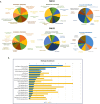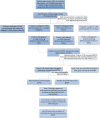Integrative multi-omic analysis identifies new drivers and pathways in molecularly distinct subtypes of ALS
- PMID: 31292500
- PMCID: PMC6620285
- DOI: 10.1038/s41598-019-46355-w
Integrative multi-omic analysis identifies new drivers and pathways in molecularly distinct subtypes of ALS
Abstract
Amyotrophic lateral sclerosis (ALS) is an incurable and fatal neurodegenerative disease. Increasing the chances of success for future clinical strategies requires more in-depth knowledge of the molecular basis underlying disease heterogeneity. We recently laid the foundation for a molecular taxonomy of ALS by whole-genome expression profiling of motor cortex from sporadic ALS (SALS) patients. Here, we analyzed copy number variants (CNVs) occurring in the same patients, by using a customized exon-centered comparative genomic hybridization array (aCGH) covering a large panel of ALS-related genes. A large number of novel and known disease-associated CNVs were detected in SALS samples, including several subgroup-specific loci, suggestive of a great divergence of two subgroups at the molecular level. Integrative analysis of copy number profiles with their associated transcriptomic data revealed subtype-specific genomic perturbations and candidate driver genes positively correlated with transcriptional signatures, suggesting a strong interaction between genomic and transcriptomic events in ALS pathogenesis. The functional analysis confirmed our previous pathway-based characterization of SALS subtypes and identified 24 potential candidates for genomic-based patient stratification. To our knowledge, this is the first comprehensive "omics" analysis of molecular events characterizing SALS pathology, providing a road map to facilitate genome-guided personalized diagnosis and treatments for this devastating disease.
Conflict of interest statement
The authors declare no competing interests.
Figures





Similar articles
-
Neuroinflammation and ALS: Transcriptomic Insights into Molecular Disease Mechanisms and Therapeutic Targets.Mediators Inflamm. 2017;2017:7070469. doi: 10.1155/2017/7070469. Epub 2017 Sep 7. Mediators Inflamm. 2017. PMID: 29081603 Free PMC article.
-
Pathways and genes differentially expressed in the motor cortex of patients with sporadic amyotrophic lateral sclerosis.BMC Genomics. 2007 Jan 23;8:26. doi: 10.1186/1471-2164-8-26. BMC Genomics. 2007. PMID: 17244347 Free PMC article.
-
Identifying Candidate Genes Associated with Sporadic Amyotrophic Lateral Sclerosis via Integrative Analysis of Transcriptome-Wide Association Study and Messenger RNA Expression Profile.Cell Mol Neurobiol. 2023 Jan;43(1):327-338. doi: 10.1007/s10571-021-01186-0. Epub 2022 Jan 17. Cell Mol Neurobiol. 2023. PMID: 35038056 Free PMC article.
-
Copy Number Variations in Amyotrophic Lateral Sclerosis: Piecing the Mosaic Tiles Together through a Systems Biology Approach.Mol Neurobiol. 2018 Feb;55(2):1299-1322. doi: 10.1007/s12035-017-0393-x. Epub 2017 Jan 24. Mol Neurobiol. 2018. PMID: 28120152 Free PMC article. Review.
-
Transcriptional analysis reveals distinct subtypes in amyotrophic lateral sclerosis: implications for personalized therapy.Future Med Chem. 2015;7(10):1335-59. doi: 10.4155/fmc.15.60. Future Med Chem. 2015. PMID: 26144267 Review.
Cited by
-
Transcriptome analysis provides critical answers to the "variants of uncertain significance" conundrum.Hum Mutat. 2022 Nov;43(11):1590-1608. doi: 10.1002/humu.24394. Epub 2022 May 18. Hum Mutat. 2022. PMID: 35510381 Free PMC article. Review.
-
Machine learning hypothesis-generation for patient stratification and target discovery in rare disease: our experience with Open Science in ALS.Front Comput Neurosci. 2024 Jan 4;17:1199736. doi: 10.3389/fncom.2023.1199736. eCollection 2023. Front Comput Neurosci. 2024. PMID: 38260713 Free PMC article.
-
Recent Advances in Pharmaceutical Design: Unleashing the Potential of Novel Therapeutics.Curr Pharm Biotechnol. 2024;25(16):2060-2077. doi: 10.2174/0113892010275850240102105033. Curr Pharm Biotechnol. 2024. PMID: 38288793 Review.
-
ASF1B: A Possible Prognostic Marker, Therapeutic Target, and Predictor of Immunotherapy in Male Thyroid Carcinoma.Front Oncol. 2022 Jan 31;12:678025. doi: 10.3389/fonc.2022.678025. eCollection 2022. Front Oncol. 2022. PMID: 35174076 Free PMC article.
-
A dataset profiling the multiomic landscape of the prefrontal cortex in amyotrophic lateral sclerosis.Gigascience. 2024 Jan 2;13:giae100. doi: 10.1093/gigascience/giae100. Gigascience. 2024. PMID: 39693632 Free PMC article.
References
Publication types
MeSH terms
LinkOut - more resources
Full Text Sources
Medical
Molecular Biology Databases
Miscellaneous

